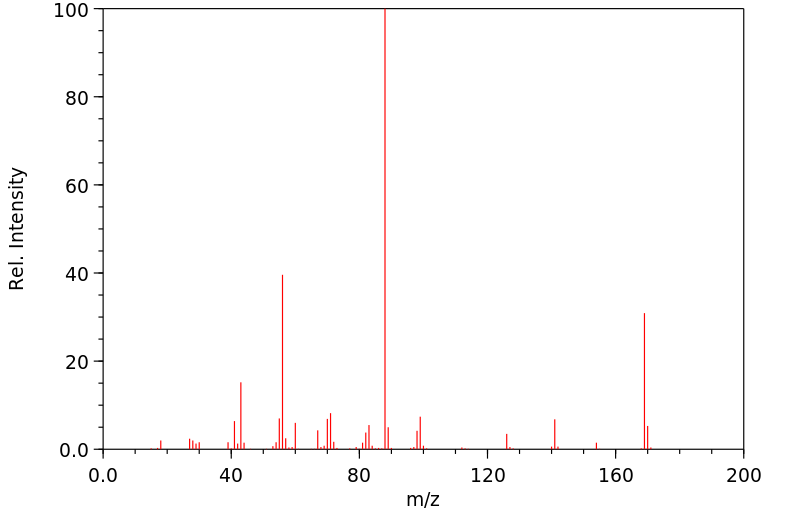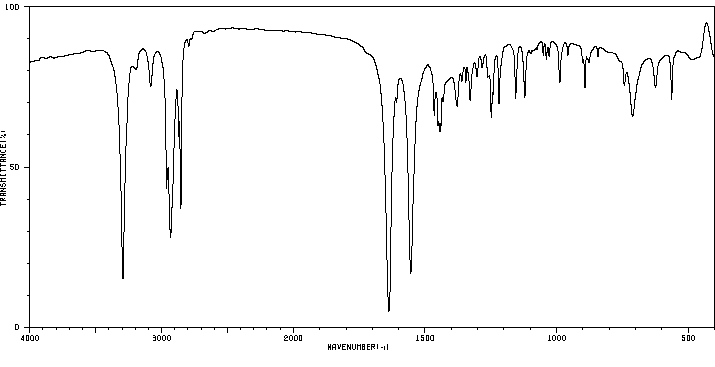N-环己基丁酰胺 | 1199-87-7
中文名称
N-环己基丁酰胺
中文别名
N-环己丁烷酰胺
英文名称
N-Cyclohexyl-butyramid
英文别名
N-cyclohexylbutyramide;N-Cyclohexylbutanamide
CAS
1199-87-7
化学式
C10H19NO
mdl
MFCD00460385
分子量
169.267
InChiKey
MIUPVUSAABKKQX-UHFFFAOYSA-N
BEILSTEIN
——
EINECS
——
-
物化性质
-
计算性质
-
ADMET
-
安全信息
-
SDS
-
制备方法与用途
-
上下游信息
-
文献信息
-
表征谱图
-
同类化合物
-
相关功能分类
-
相关结构分类
物化性质
-
保留指数:1459
计算性质
-
辛醇/水分配系数(LogP):2.2
-
重原子数:12
-
可旋转键数:3
-
环数:1.0
-
sp3杂化的碳原子比例:0.9
-
拓扑面积:29.1
-
氢给体数:1
-
氢受体数:1
安全信息
-
海关编码:2924299090
SDS
反应信息
-
作为反应物:参考文献:名称:THE SYNTHESIS OF 1,5-DISUBSTITUTED TETRAZOLES摘要:DOI:10.1021/jo01149a035
-
作为产物:描述:S-苄基-S-苯基-N-对甲苯磺酰硫亚胺 以80%的产率得到参考文献:名称:OAE S.; AIDA T.; FURUKAWA N., CHEM. AND PHARM. BULL.
, 1975, 23, NO 11, 3011-3016 摘要:DOI:
文献信息
-
[EN] TRICYCLIC DEGRADERS OF IKAROS AND AIOLOS<br/>[FR] AGENTS DE DÉGRADATION TRICYCLIQUES D'IKAROS ET D'AIOLOS
-
Direct Regioselective Synthesis of Tetrazolium Salts by Activation of Secondary Amides under Mild Conditions作者:Veronica Tona、Boris Maryasin、Aurélien de la Torre、Josefine Sprachmann、Leticia González、Nuno MaulideDOI:10.1021/acs.orglett.7b01004日期:2017.5.19Tetrazolium salts are biologically active molecules that have found broad applications in biochemical assays. A regioselective synthesis of tetrazolium salts is described through a formal (3 + 2) cycloaddition. The possibility of employing simple amides and azides as starting material and the mild conditions allow a broad functional group tolerance.
-
A 1,3-DIPOLE IN SULFILIMINE-PHOSPHINE SYSTEM (III) ACID ANHYDRIDE-, ESTER-, AND AMIDE-CONDENSATIONS BY SULFILIMINE-PHOSPHINE SYSTEM作者:Tetsuo Aida、Naomichi Furukawa、Shigeru OaeDOI:10.1246/cl.1975.29日期:1975.1.5Alkyl phenyl N-p-tosylsulfilimine and triphenylphosphine reacted with various carboxylic acids affording their anhydrides. The reaction was successfully extended to an ester- or amide-condensation reaction. These results can be interpreted by the initial formation of a 1,3-dipole between the sulfilimine and the phosphine.
-
<i>N</i>-Acyl-<i>N</i>-(4-chlorophenyl)-4-nitrobenzenesulfonamides: highly selective and efficient reagents for acylation of amines in water作者:Sara Ebrahimi、Safoura Saiadi、Simin Dakhilpour、Seyed Nezamoddin Mirsattari、Ahmad Reza MassahDOI:10.1515/znb-2015-0076日期:2016.2.1been developed as chemoselective N-acylation reagents. Selective protection of primary amines in the presence of secondary amines, acylation of aliphatic amines in the presence of aryl amines, and monofunctionalization of primary-secondary diamines as well as selective N-acylation of amino alcohols using these reagents are described. All of the acylation reactions were carried out in water as a green
-
Some amide forming reactions involving boron reagents作者:A. Pelter、T.E. Levitt、P. NelsoniDOI:10.1016/s0040-4020(01)92983-7日期:1970.1Attempts to evolve a new peptide synthesis using boron reagents have led to several new amide syntheses, involving either trialkylboranes. trialkoxyboranes, chlorodialkoxyboranes or dialkoxyboranes. The method using the readily available trimethoxyborane may be of general synthetic value. A new peptide synthesis was realized that gave a product of high optical purity but the low conversions achieved do not
表征谱图
-
氢谱1HNMR
-
质谱MS
-
碳谱13CNMR
-
红外IR
-
拉曼Raman
-
峰位数据
-
峰位匹配
-
表征信息
同类化合物
(±)17,18-二HETE
(±)-辛酰肉碱氯化物
(Z)-5-辛烯甲酯
(Z)-4-辛烯酸
(R)-甲羟戊酸锂盐
(R)-普鲁前列素,游离酸
(R,R)-半乳糖苷
(E)-4-庚烯酸
(E)-4-壬烯酸
(E)-4-十一烯酸
(9Z,12E)-十八烷二烯酸甲酯
(6E)-8-甲基--6-壬烯酸甲基酯-d3
(3R,6S)-rel-8-[2-(3-呋喃基)-1,3-二氧戊环-2-基]-3-羟基-2,6-二甲基-4-辛酮
龙胆二糖
黑曲霉二糖
黄质霉素
麦芽酮糖一水合物
麦芽糖醇
麦芽糖酸
麦芽糖基蔗糖
麦芽糖一水合物
麦芽糖
鳄梨油酸乙酯
鲸蜡醇蓖麻油酸酯
鲸蜡醇油酸酯
鲸蜡硬脂醇硬脂酸酯
鲸蜡烯酸脂
鲸蜡基花生醇
鲫鱼酸
鲁比前列素
鲁比前列素
高级烷基C16-18-醇
高甲羟戊酸
高效氯氰菊酯
高-gamma-亚油酸
马来酸烯丙酯
马来酸氢异丙酯
马来酸氢异丁酯
马来酸氢丙酯
马来酸氢1-[2-(2-羟基乙氧基)乙基]酯
马来酸单乙酯
马来酸单丁酯
马来酸二辛酯
马来酸二癸酯
马来酸二甲酯
马来酸二烯丙酯
马来酸二正丙酯
马来酸二戊基酯
马来酸二异壬酯
马来酸二异丙酯








